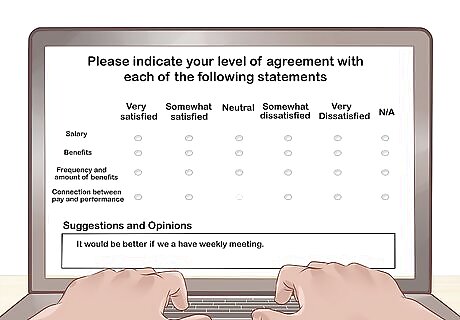
views
Conducting Surveys

Use regular pulse surveys to look for changing trends. Pulse surveys are a fast and frequent survey of a few short questions that track the overall health of a company’s culture. Companies can use pulse survey software or create their own questions to track changes in employee engagement and build comprehensive metrics. These surveys are typically sent out either weekly or monthly, and include questions like: Are there thing you don’t know about the company that you feel you should know? What challenges are you currently facing in your role? What goals have you been able to achieve in the past week or month? Is there anything here preventing you from doing your best work?

Use annual performance reviews to ask more in-depth questions. Let employees use annual performance reviews as a way to review the company, as well. Build a self-review section that allows employees to talk about what they feel the company is doing well, where they think things are missing, and what resources they would like to see from their employer. Use annual reviews as an opportunity to build upon pulse survey questions. Ask things like, “What were your greatest challenges this year?” and “What would like to see from your company that would help you excel in the coming year?” Annual surveys are a chance to not only ask what but why. If your employees regularly say they feel overworked or underappreciated, ask them why the company environment makes them feel that way.

Create a space to voice concerns and opinions outside of surveys. Surveys are a good way of checking on individual opinions, but they shouldn’t be the only method of communication. Create a means of allowing employees to voice their concerns outside of scheduled surveys. Use an anonymous online form or app to help your employees feel comfortable expressing their concerns.

Set aside time each week to let your employees meet with you. Designate 1-2 hours of open office time each week to let your employees come to you. This should be separate from any 1-on-1 meetings, serving as a time for your employees to come to you if they choose. Let them know that this is a time when your doors will be open to listen to their concerns, hear their ideas, and discuss the company as a whole.
Monitoring Office Collaboration

Quantify the connections between departments. A willingness to work with other departments is often considered a strong indicator of an employee or department’s commitment to their company. Keep a running total of formal interdepartmental interactions, including meetings, projects, and other collaborative efforts that aren’t mandated by company function. If your company sells toys, for example, a meeting between marketing and product designers may be mandatory if a new toy is about to roll out. If, however, they collaborate to talk about toy trends for the next year, that could be a marker of engagement. You can monitor this on a spreadsheet, through your employee's calendars, or any method that makes sense with your organization's management systems.

Watch how often your employees get together outside the office. Along with interdepartmental collaboration, strong connections between employees is a positive indicator of engagement. Try to keep a tally or running total of how often your employees do things like go out for a drink together, participate in an office potluck, or engage in other informal, non-mandatory bonding activities. This should be an informal or approximate count. Do not request that employees let someone know every time they hang out in a group, as that would be incredibly off-putting.

Monitor time spent in meetings versus time actually working. Collaboration is a strong indicator of engagement, but it needs follow-through. If employees are only meeting and not following through on their work, they may not be engaged in their jobs. Look at the amount of time employees spend in large or long meetings over the course of the day. The less space they have to make their voice heard and the more time they need to devote to being away from their work, the less likely they are to be engaged. Ask managers or someone who has access to employee calendars to keep a running metric of how long their employees spend in meetings on average, and how large these meetings are. Generally, if employees spend a lot of time in meetings with more than 20 attendees, or if they don’t have at least a 2-hour break between meetings, they are less likely to be engaged in their job.
Checking with Individual Employees

Set up 1-on-1 meetings. Quantitative data is important, but so is simply talking to your employees. Consider setting quarterly or semi-annual 1-on-1 meetings to check in with employees regarding their feelings about their job. Aim to create a space where they won’t feel threatened or afraid to express an honest opinion. These meeting not only let you hear about what your employees like and dislike about their jobs directly from them, they also let you directly see engagement. Body language and tone of voice can let you know if an employee is unenthusiastic, even if all their comments are positive.

Watch employee social media. Social media use at work isn’t as taboo as it used to be, but it should still be monitored for two reasons. First, what an employee says about their company or their job on social media can be an indicator of their opinions about their position. Second, employees who are able to spend ample time posting or scrolling through social media at work may not be challenged by or engaged in their position. Do not look at social media monitoring as a way to target problematic behaviors by troublesome employees. Use this as a way to see if employees are engaged in their jobs. If they don't seem engaged, start thinking of strategies to increase engagement. In addition to looking at employee social media accounts, check sites like Glassdoor. These sites let job candidates and employees post reviews and opinions about your company.

Perform exit interviews anytime an employee leaves the company. Employees will often be their most frank during their exit interviews. That is why it is important to do one every time an employee voluntarily leaves your company. Even if they are leaving on good terms, they may feel more comfortable talking about what they want from the company when they don’t feel their position is at risk. Ask the same kinds of “why” questions that you would during an annual review, such as “Do you feel like your ideas and opinions were given a fair voice? Why or why not?” Trends in exit interview answers may provide you with insight into where your company needs to focus its engagement efforts.

Watch individual body language. Even if your employees are hesitant to speak with you about specific ideas and concerns, their body language can portray a lot. Listen to your employee's tone and watch their body language to help you discern their engagement. Fidgeting playing with items on their desk, for example, may indicate an employee is anxious, nervous, or feeling overworked. Constantly looking away, a friendly but distant tone, or constant staring off may indicate an employee is not engaged in their position. Conversely, emotional tones such as excitement, anger, or joy and body signals like leaning in, smiling, or making intense eye contact may indicate engagement.














Comments
0 comment